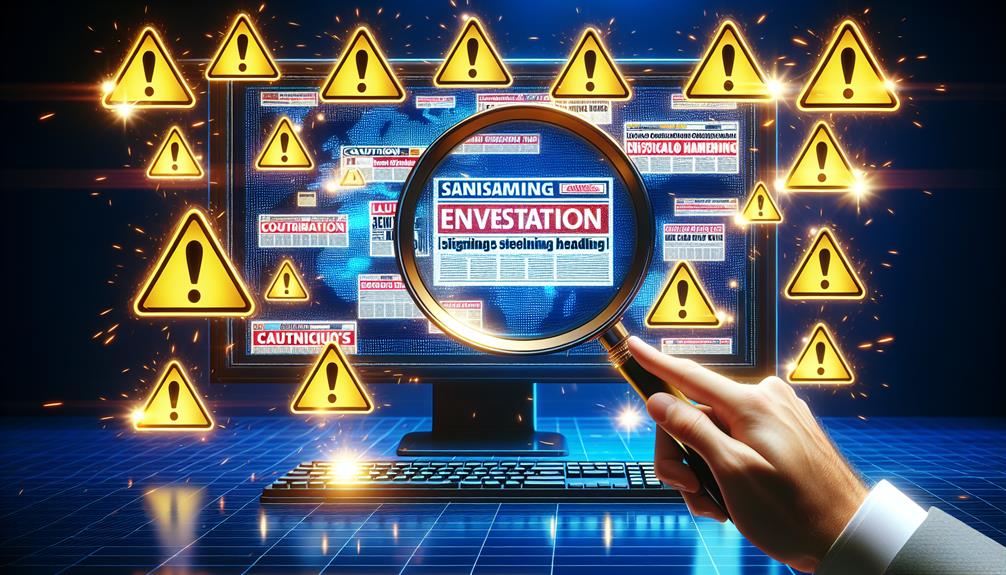Is it truly possible to always spot a clickbait article before you’ve clicked through? You’ve likely encountered headlines that promise earth-shattering revelations only to lead to underwhelming content. The trick lies in analyzing these headlines critically: look for sensationalism, overly emotional cues, or promises of easy solutions. You should also check the source’s credibility and seek out any immediate contradictions within the article itself. Knowing these strategies is just the beginning, though. The deeper question is, how often do these signs slip past undetected and what does that tell us about our media consumption habits?
Clickbait Articles
You’ve likely encountered clickbait articles online, those headlines that grab your attention but don’t always deliver on their promises.
Let’s explore what truly defines a clickbait article and the impact they’ve on your browsing experience.
Understanding these elements can help you navigate the web more effectively, avoiding traps and finding genuine content.
What are Clickbait Articles?
You’ve likely encountered clickbait articles online, those headlines that seem irresistible, promising shocking or sensational content. They’re designed to grab your attention and tempt you to click through, often leading to content that doesn’t quite live up to the hype.
Understanding their common traits helps you recognize them quickly and decide whether they’re worth your time.
Definition and Characteristics
Clickbait articles are designed to lure you in with sensational headlines that often promise more than the content delivers. They typically use exaggeration, emotional triggers, or misleading information to increase clicks.
You’ll find them capitalizing on your curiosity, often leaving you with unsatisfied expectations. Recognize them by their vague, provocative phrasing and the urgent ‘You won’t believe…’ or ‘This one trick…’ style.
Impact of Clickbait Articles
As you explore the impact of clickbait articles, consider how they not only affect readers’ trust but also shape publishers’ reputations.
You’ll find that these tantalizing headlines often lead to underwhelming content, potentially eroding reader engagement over time.
Moreover, for publishers, the short-term traffic boosts can come at the cost of long-term credibility and reader loyalty.
On Readers and Publishers
Understanding the impact of clickbait articles requires examining how they affect both readers and publishers. For you, as a reader, clickbait can mislead you with sensational headlines, often leading to disappointment with the actual content.
Publishers, on the other hand, might see short-term traffic increases but risk long-term credibility damage. It’s a precarious balance between attracting views and maintaining trust.
Identifying Clickbait Articles
As you navigate the web, it’s important to recognize the common tactics used in clickbait articles.
You’ll need tools to effectively detect these misleading headlines and content.
Understanding these strategies will empower you to sift through information with a critical eye.
Common Clickbait Tactics
You’ve likely seen them: articles with flashy headlines and eye-catching images that seem too dramatic to be true. These are classic examples of clickbait tactics, where sensational content is used to lure you into clicking.
Understanding how these elements manipulate your curiosity can help you avoid wasting time on low-quality articles.
Sensational Headlines and Images
Clickbait articles often lure readers in with sensational headlines and eye-catching images that promise more than they deliver. You’ll find exaggerated claims or emotionally charged language designed to spark curiosity and clicks.
Don’t be fooled; these headlines rarely provide substantial content. Always check for reputable sources before diving in. Remember, if it sounds too dramatic or too good to be true, it probably is.
Tools for Detection
Now, you’ll want to know how to spot these sneaky clickbait articles effectively.
Luckily, there are tools like browser extensions and fact-checking sites designed specifically to help you. These resources can quickly identify misleading headlines and verify information, making it easier for you to navigate through the noise.
Browser Extensions and Fact-Checking Sites
To effectively spot clickbait, consider using browser extensions and visiting fact-checking sites that specialize in exposing deceptive headlines. These tools scrutinize content in real-time, alerting you to misleading or sensationalized information.
They’re easy to install and operate seamlessly as you browse, enhancing your ability to discern factual news from attention-grabbing but unreliable articles.
Start empowering yourself today with these smart, practical solutions.
Challenges of Clickbait Detection
As you tackle the task of detecting clickbait, you’ll quickly find that subjectivity poses a major challenge. Each person might interpret an article’s clickbait nature differently, complicating consistent identification.
Moreover, as clickbait strategies continuously evolve, staying ahead of new tactics becomes an ongoing battle.
Subjectivity in Clickbait Assessment
Evaluating clickbait isn’t just about spotting sensational headlines; it’s also about understanding the nuanced tactics used.
You’ll find that by examining real-life examples and case studies, the patterns and common strategies become clearer.
Each instance offers a unique insight into how clickbait manipulates reader engagement and skews content presentation.
Case Studies and Examples
Evaluating clickbait’s allure highlights how personal biases often complicate the detection process. Here’s what you should consider:
- Headline Sensationalism: Exaggerated claims can sway your judgment.
- Emotional Triggers: Personal experiences shape how you react to content.
- Click Histories: Your past clicks influence future perceptions.
Understanding these factors deepens your ability to discern genuine content from clickbait, enhancing your browsing experience.
Evolution of Clickbait Strategies
Clickbait strategies have continually evolved, making it increasingly challenging to detect and differentiate them from genuine content. As you’ve probably noticed, what started as sensational headlines to lure readers has morphed into a complex mix of emotionally charged triggers, misleading previews, and strategically placed social media posts.
You’re not just up against bold, capitalized titles anymore; you’re facing a smart, algorithm-driven machine that knows your clicks better than you do. These evolving tactics mean that traditional detection tools, which often scan for exaggerated language or look for certain keyword patterns, aren’t as effective.
You’re now dealing with subtler forms of clickbait that blend almost seamlessly with the type of content you trust. They might mimic the style of credible news sources or offer just enough truth to make you pause and consider clicking.
To stay ahead, you need to sharpen your skills. Start by critically evaluating the source and cross-checking information. Pay attention to the URL and the site’s layout—authentic platforms have a more professional design and fewer intrusive ads.
Also, consider the emotional response the article triggers; genuine articles aim to inform, not manipulate feelings. By staying alert and skeptical, you can better navigate this tricky landscape.
Solving Clickbait Puzzles
You’ve recognized the clickbait; now, how do you avoid falling into these traps? We’ll explore practical tips that keep you from clicking impulsively, ensuring you spend your time on content that truly matters.
Additionally, we’ll solve some clickbait-themed crossword clues to sharpen your detection skills in a fun and engaging way.
Tips for Avoiding Clickbait Traps
As you navigate the vast sea of online content, mastering critical reading techniques is essential to sidestep clickbait traps. You’ll need to scrutinize headlines critically and assess the source’s credibility before clicking through.
Critical Reading Techniques
To effectively dodge clickbait traps, you’ll need to refine your critical reading skills. Here’s how:
- Analyze Headlines: Look for sensational or overly dramatic phrases; they’re often bait.
- Check Sources: Verify the credibility by researching the publisher and author.
- Read Beyond: Don’t stop at the headline. Dive deeper into the article to see if the content truly matches the teaser.
Some Clickbait Articles Crossword Clue
You’ve probably encountered clickbait titles that puzzle you like a tricky crossword clue.
To untangle these misleading cues, you’ll need to scrutinize the headline’s promise versus the article’s actual content.
Deciphering Misleading Clues
Let’s break down the misleading clues that often make clickbait articles so puzzling:
- Exaggerated Headlines: These promise shocking revelations that the article doesn’t deliver.
- Vague Details: They tease information without giving anything concrete, luring you to click.
- Emotional Appeal: They play on your feelings to provoke curiosity and urgency.
Identifying these tricks can help you avoid wasting time on clickbait content.




